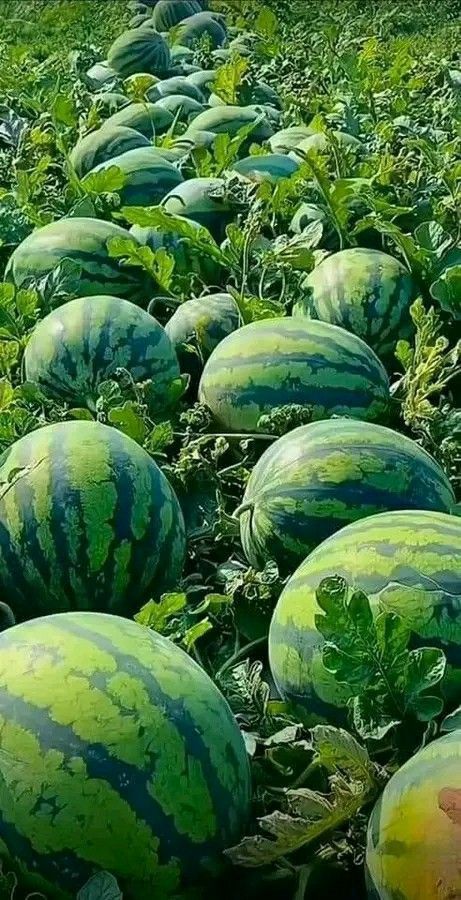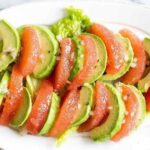Watermelon, cantaloupe, and honeydew are familiar fruits commonly found in the daily lives of Vietnamese people. Especially watermelon, with its hard green rind, juicy red flesh, and black seeds, is not only delicious but also offers numerous health benefits. Cantaloupe is similar in this regard. From the rind to the flesh and even the seeds, every part of these fruits can be utilized: the flesh is refreshing, the rind helps with heat relief and detoxification, while the seeds make for a nutritious snack.
Growth Characteristics of Watermelon, Cantaloupe, and Honeydew
Watermelon, cantaloupe, and honeydew are typically creeping vines that sprawl along the ground during their growth. Suited to the climatic conditions of all three regions of Vietnam, they are widely cultivated across the country. As a result, watermelons, in particular, tend to be affordable and easily accessible compared to many other types of fruit.
The growth process of these fruits is quite unique. From fruit set to harvest, the fruits always rest directly on the ground. This characteristic has also sparked debates about whether it is appropriate to use watermelons for ancestral offerings.

Why Some People Avoid Using Watermelon, Cantaloupe, and Honeydew for Ancestral Offerings
Choosing fruits to offer to ancestors and deities is not only a way to show reverence but also requires consideration of purity and sanctity. The altar is considered a sacred space, and the offerings are carefully selected to maintain the spiritual energy within this space.
However, some people believe that watermelon, cantaloupe, and honeydew are not suitable for placement on the altar for the following reasons:
- Creeping along the ground: During their growth, these fruits remain close to the ground, which is believed to be susceptible to “evil influences” and the absorption of impurities from the surrounding environment, especially from fertilizers, insects, or contact with unclean elements.
- Storage and trading: When harvested and transported to markets, these fruits are often piled or placed on the ground, sidewalks, or outdoor mats, raising concerns about their purity for ancestral offerings.
- Spiritual beliefs: Some believe that only fruits growing on tall branches, away from the ground, should be offered, such as bananas, oranges, jackfruit, custard apples, mangoes, and pomegranates. These fruits are considered more yang, clean, and pure.
Based on these beliefs, many families choose to refrain from placing watermelon, honeydew, and cantaloupe on their altars, especially during important occasions like Tet, the full moon, or the first day of the lunar month.
However, Some Places Still Use Watermelon for Ancestral Offerings
Despite the taboos, many families continue to use watermelon, cantaloupe, and honeydew for offerings, especially during the traditional Tet holiday. In feng shui, the word “dưa” (watermelon) sounds similar to “dư” (surplus), symbolizing abundance, fullness, and prosperity. This is why watermelons are still included in the five-fruit trays in some regions.

Notes on Displaying Watermelon on the Ancestral Altar
If you still wish to use watermelon, cantaloupe, or honeydew for offerings, keep the following in mind to ensure propriety and safety:
- Choose appropriately sized fruits: Select fruits that match the size of your altar. For altars hung at a height, avoid choosing overly large or heavy fruits to prevent imbalance or breakage.
- Maintain hygiene: Before placing them on the altar, clean the outer rind to remove dirt and bacteria, ensuring cleanliness and respect.
- Do not leave them for too long: These fruits have a high water content and can spoil quickly, especially in hot weather. Even if the outer rind looks fresh, the inner flesh may have deteriorated if left on the altar for an extended period.
- Choose ripe fruits: Ripe watermelons and cantaloupes typically have hard rinds, small stem ends, and deep, even green colors. These characteristics indicate sweeter, juicier, and longer-lasting fruits.
Watermelon and cantaloupe are nutritious and beloved fruits known for their refreshing taste. However, when it comes to worship and offerings, each family should consider their spiritual beliefs, altar space, and local traditions to make an appropriate choice. Regardless of whether you choose to offer these fruits or not, the most important aspect is the sincerity and reverence of the family towards their ancestors.
Reference information for contemplation
How to Select the Finest Naturally Ripened Fruits
How do you know when fruit is ripe and ready to eat? It’s a tricky question, and one that many of us get wrong. Picking the perfect fruit is an art, and we’re here to share some insider tips on how to choose nature’s candy at its very best. Learn how to select fruit that’s ripe, sweet, and packed with flavor with our expert guide.
Why Do Vietnamese People Often Chant ‘Nam Mo A Di Da Phat’ While Praying with Incense?
“Chắt tay và niệm ‘Nam mô a di đà Phật’ is a sacred ritualistic practice deeply ingrained in Vietnamese culture. This act of piety and devotion is often performed during religious ceremonies and holds a special significance for the Vietnamese people. While it may seem like a simple gesture to some, the true meaning behind it is profound and rooted in the country’s rich spiritual heritage.”



































